Key insights
- According to the Office for National Statistics (ONS), the median weekly earnings for all types of jobs in London gradually increased from 2012 to 2021.
- Statista reports that London has the highest median annual earnings in the United Kingdom, with workers earning £47,455 on average per year.
- Among the boroughs in London, Kensington and Chelsea had the highest average weekly wage, Statista reports.
- ONS states managers, directors, and senior officials have the highest median weekly earnings.
- The Times Money Mentor reports that the salary peaks in a worker’s forties, reflecting the financial benefits of career progression.As of April 2024, ONS states that men earn more per hour on average than women.The Greater London Authority (GLA) has implemented several measures to combat the effect of inflation on median salaries.
From 2012 to 2021, data from the Office for National Statistics (ONS) shows that median weekly earnings for all types of jobs gradually increased, though there were some small changes in certain years. Full-time workers consistently earned more than part-time workers.
However, there was a sharp rise in earnings starting in 2022, especially for full-time employees.
This increase continued in 2023 and 2024. One major reason for this was the UK’s economic recovery after the COVID-19 lockdowns. As businesses reopened, they had to offer higher wages to attract workers back into the job market.
In April 2024, ONS reported that the average full-time worker in the UK earned £728 per week. This was a 6.0% increase from the previous year.
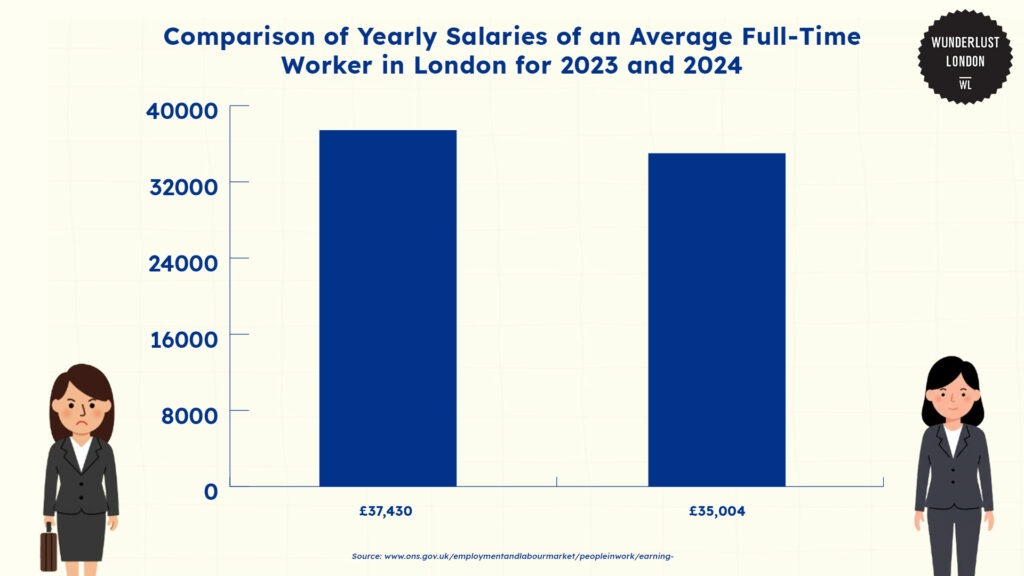
In yearly salaries, the average full-time worker earned £37,430 in 2024, compared to £35,004 in 2023. This shows that wages have been growing steadily across different job sectors.
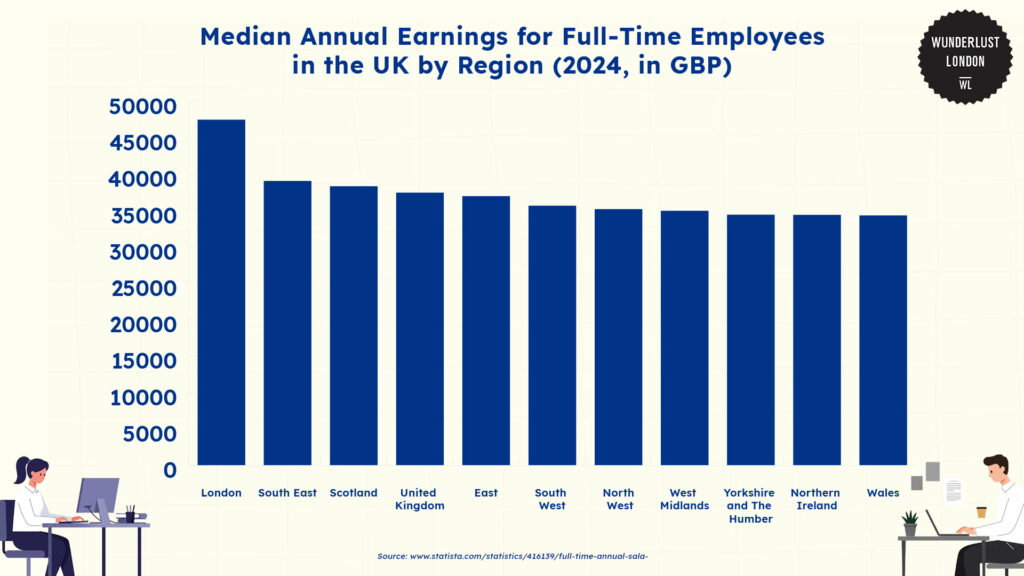
According to Statista, London has the highest median annual earnings in the United Kingdom, with workers earning £47,455 on average per year.
In addition to London, two other regions also reported earnings above the UK average.
South East England had a median annual salary of £39,038, while Scotland followed closely with £38,315. These figures highlight regional differences in income levels across the country.
London’s higher median salaries compared to other UK regions can be attributed to several key factors, including the elevated cost of living and the concentration of high-paying industries.
Regional analysis of median salary in London
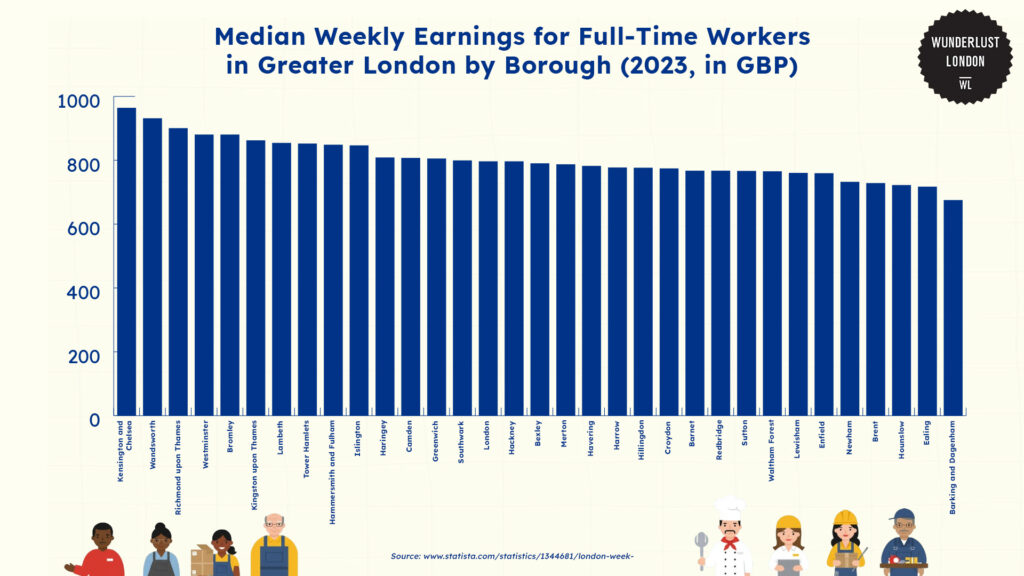
In 2023, full-time workers living in Greater London earned an average of £796 per week, according to Statista.
Among the boroughs, Kensington and Chelsea had the highest average weekly wage at £964, while Barking and Dagenham had the lowest at £675 per week.
Demographics breakdown of median salary in London
Median salary by occupation in London
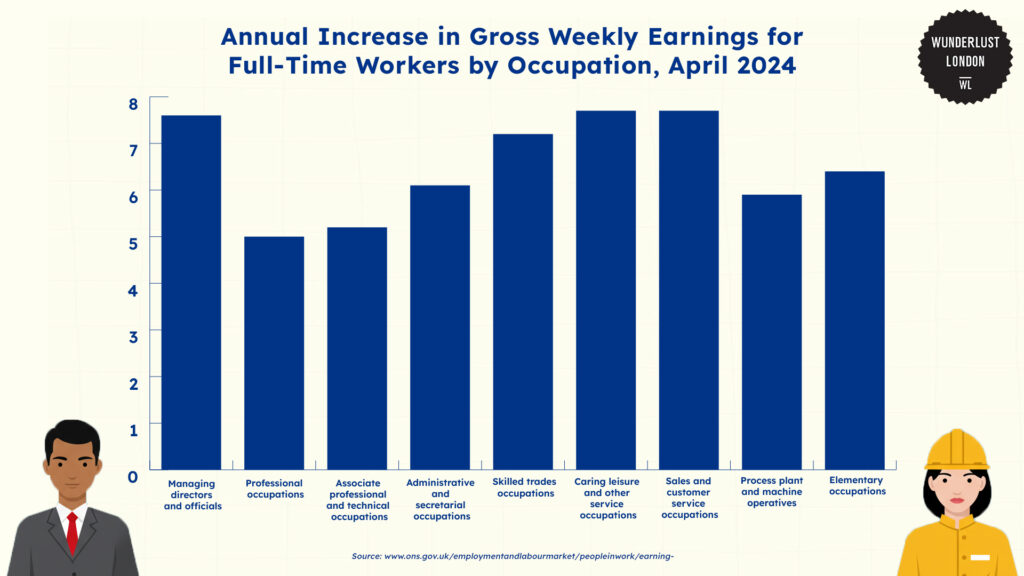
According to ONS, wages increased for all full-time employees across different job sectors as of April 2024.
Managers, directors, and senior officials experienced the largest increase, reflecting strong salary growth at higher levels.
Sales and customer service roles and caring, leisure, and other service occupations also had significant wage growth. This may be due to increased demand for these jobs.
Skilled trades and administrative roles saw steady wage increases, likely driven by the need for specialised skills.
On the other hand, process plant and machine operatives, along with elementary occupations, had the lowest growth.
Median salary by industry in London
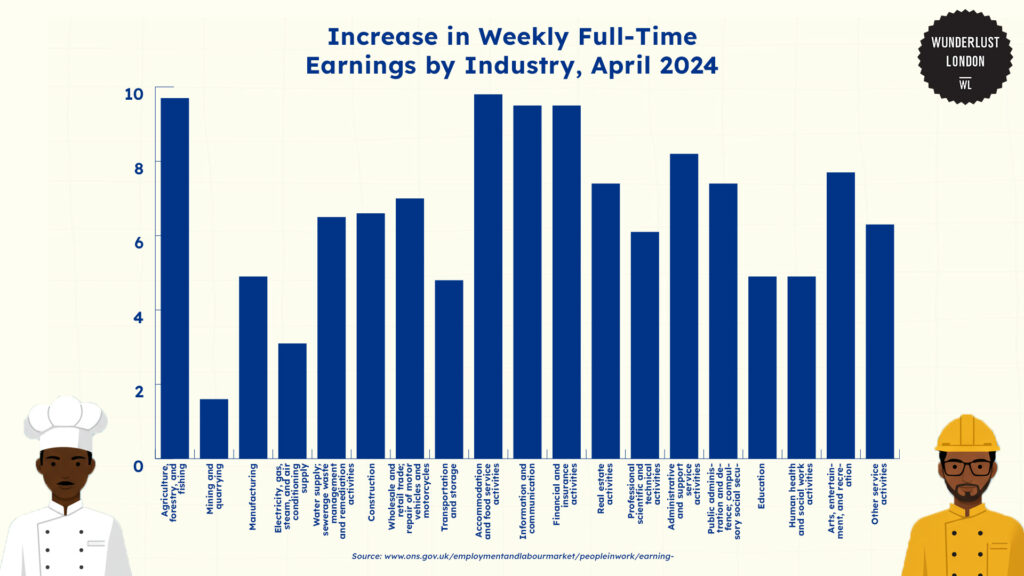
In another report by ONS, agriculture, forestry, and fishing show the most significant wage increase. Accommodation and food service activities also experienced a strong increase, reflecting the continued demand for workers in hospitality and tourism.
Other industries with notable wage growth include information and communication, financial and insurance activities, and arts, entertainment, and recreation. These sectors likely benefited from economic recovery and increased consumer spending.
Some industries, such as mining and quarrying and education, had relatively lower wage growth. This could indicate slower demand for workers or more stable wage structures in these fields.
Transportation and storage also saw limited earnings growth, which may reflect challenges in the logistics sector.
Median Salary by age group in London
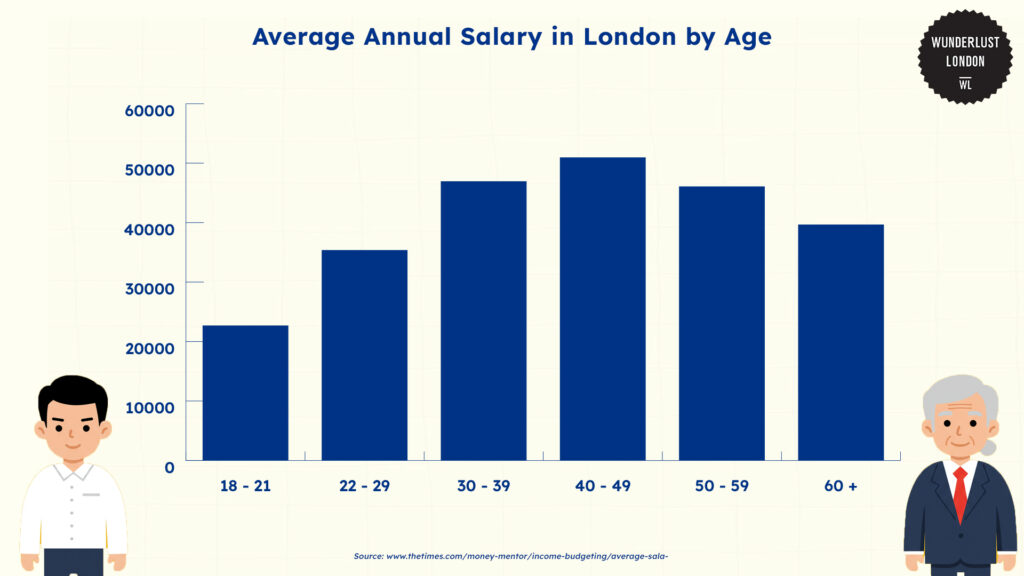
In London, as in the rest of the UK, younger workers tend to earn the least.
The Times Money Mentor reports that earnings continue to increase with age. The salary peaks in a worker’s 40s when they have likely built strong expertise, advanced in their careers, and taken on higher-paying roles.
The average salary of £50,963 at this stage reflects the financial benefits of career progression.
However, earnings start to decline after 50. This could be due to several factors, including a shift towards part-time or less demanding roles, career stagnation, or early retirement choices.
The average salary drops to £36,674 for those aged 60 and over. This may reflect a reduced presence in the workforce or a preference for lower-paid but less stressful positions.
The gender pay gap in London
The ONS reports that, as of April 2024, men earn more per hour on average than women. The gender pay gap among full-time employees was 7.0% in April 2024, down from 7.5% in April 2023. Several factors contribute to this disparity.
Men and women often work in different industries, with women being more concentrated in lower-paying sectors such as care and leisure. Men, on the other hand, are more likely to be in higher-paying professions.
Career interruptions, particularly for childcare or family responsibilities, also contribute to the gap. Women who take breaks from work may experience slower career progression, leading to lower earnings over time.
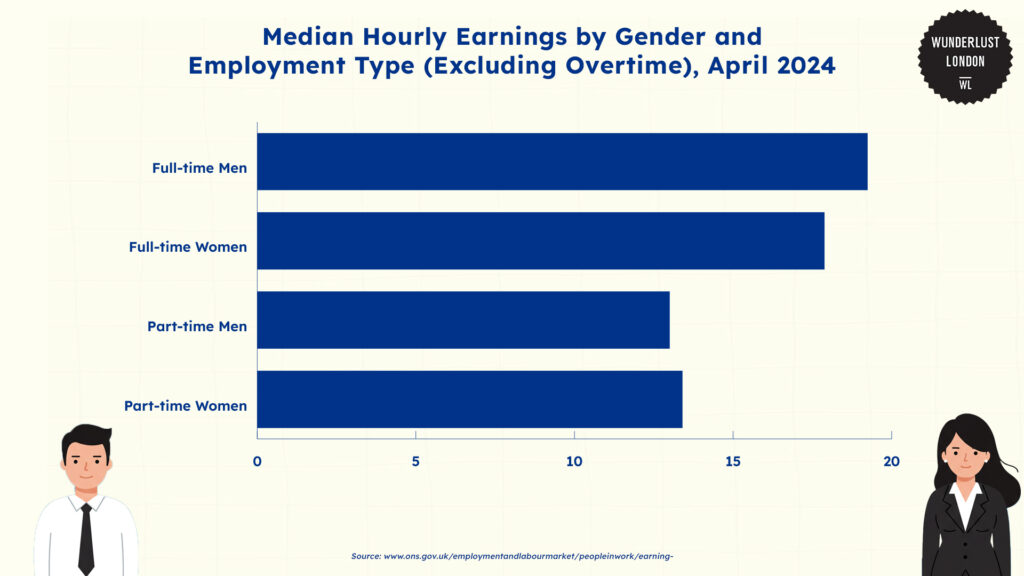
According to ONS, in April 2024, the gender pay gap for part-time employees was negative at 4.0%, indicating that part-time women earned slightly more per hour than part-time men.
This disparity may be due to the types of industries and roles that part-time men and women occupy.
A research briefing from the UK Parliament indicates that 38% of women in employment work part-time, compared with 14% of men.
Women are more likely to be in higher-paying sectors such as healthcare, education, and administration, which often require specialised skills or qualifications.
Conversely, men in part-time roles are more commonly found in lower-paying sectors like manual labour or retail. In contrast, men dominate higher-paying full-time positions, widening the gender pay gap in that category.
Initiatives and policies to address pay disparities in London
London has introduced several initiatives to address the gender pay gap and promote workplace equality.
The Greater London Authority (GLA) Pay Gap Action Plan 2021 includes measures such as integrating diversity and inclusion into performance reviews and improving work-life balance policies.
Updates to maternity, shared parental leave, and premature birth policies aim to support working families better and reduce disparities.
The impact of economic factors to salary trends in London
Economic factors like inflation and employment rates majorly impact salary trends. When inflation rises, the cost of living increases, making everyday essentials more expensive.
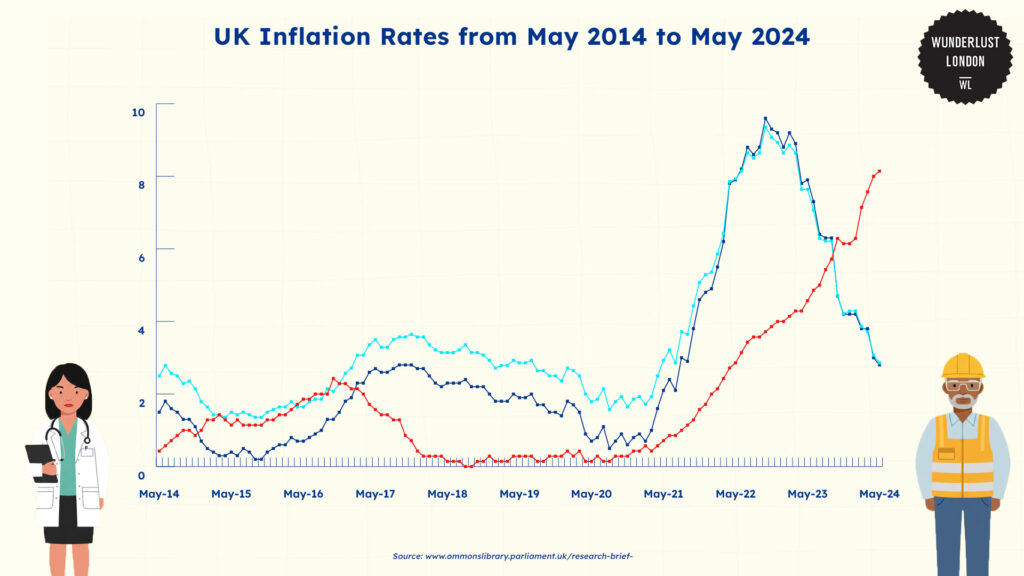
The UK parliament states that inflation peaked at 11.1% in October 2022. This means that even if wages increased, their actual value—or purchasing power—declined.
Employment levels also affect wages. When unemployment is low, businesses compete for workers, which often leads to higher salaries.
In late 2024, ONS reported that wage growth in the UK reached 5.6%, partly due to a strong job market.
However, increasing wages can also push prices higher. If businesses raise salaries, their costs go up, and they may charge more for products and services, contributing to further inflation. This cycle can make it harder to control rising prices
Trends in London’s median salaries and inflation adjustments
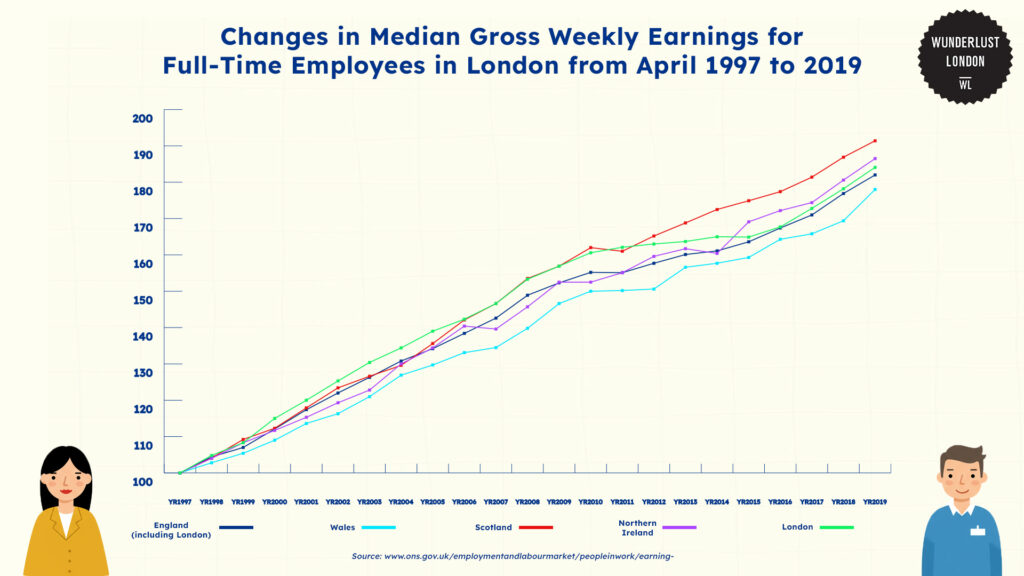
Over the past five years, ONS reveals that median salaries in London have exhibited a general upward trend. In 2019, the median weekly earnings for full-time employees in London were £736.
By 2023, this figure had risen to an average gross annual salary of £44,370, according to The Times Money Mentor. This indicates a consistent increase over the period.
However, when adjusting for inflation, the real value of these earnings has experienced fluctuations.
Between 2010 and 2024, the UK Parliament reports that London saw one of the largest decreases in median full-time earnings in real terms among UK regions.
This suggests that while nominal salaries have increased, inflationary pressures have affected the purchasing power of these earnings.
Despite these challenges, London’s median earnings remain higher than the national average, reflecting the city’s role as a central hub for high-paying industries such as finance, technology, and professional services.
This trend underscores the dynamic nature of London’s labour market and its resilience in the face of economic fluctuations.
Interventions of the London government about inflation and median salaries
The London government has implemented several measures to mitigate the impact of inflation on median salaries.
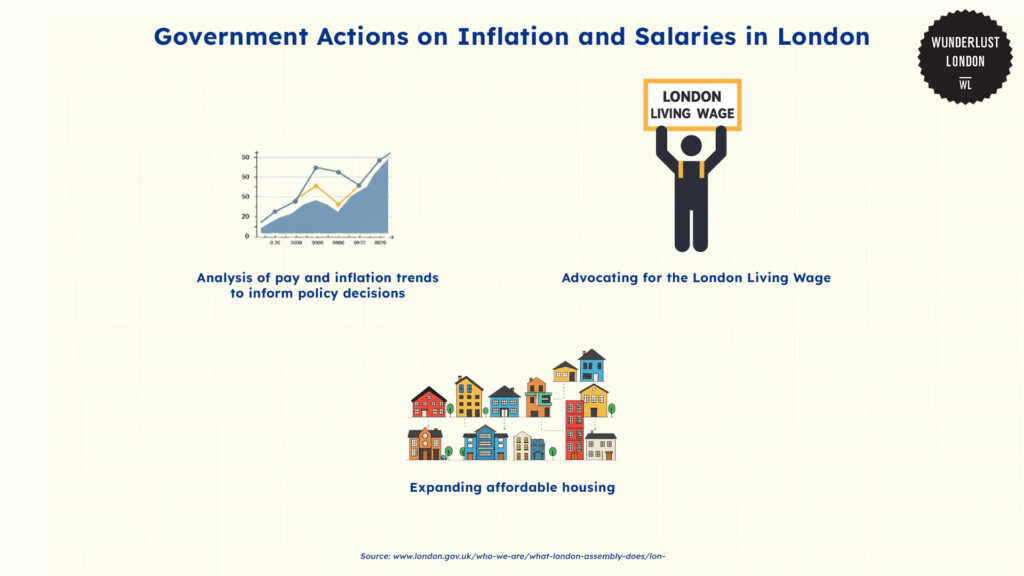
The Greater London Authority (GLA) regularly analyses pay and inflation trends to inform policy decisions.
For instance, the GLA’s “Pay and Inflation Trends in London and the UK, 2010-2022” report provides insights into how earnings have evolved with inflation, aiding in the development of targeted interventions.
The GLA also advocates for employers to adopt the London Living Wage, which is higher than the national minimum wage and is calculated based on the cost of living in the city. This initiative aims to ensure that workers’ earnings keep pace with living expenses.
Additionally, policies to expand affordable housing help reduce living expenses, improving financial stability for workers.
These measures aim to protect earnings and maintain purchasing power despite inflationary pressures.
References
- Clark, D. (2025). London weekly wage amount by borough 2023. Statista. https://www.statista.com/statistics/1344681/london-weekly-wage-amount-by-borough/
- Clark, D. (2024). UK full-time annual salary by region 2024. Statista. https://www.statista.com/statistics/416139/full-time-annual-salary-in-the-uk-by-region/
- Francis-Devine, B. (2024). Average earnings by age and region – house of commons library. UK Parliament: House of Commons Library. https://commonslibrary.parliament.uk/research-briefings/cbp-8456/
- Francis-Devine, B., Harari, D., Keep, M., Bolton, P., Barton, C., Harker, R., & Cromarty, H. (2024). Rising cost of living in the UK. UK Parliament: House of Commons Library. https://commonslibrary.parliament.uk/research-briefings/cbp-9428/
- Gla pay gap action plan 2021. London City Hall. (2023). https://www.london.gov.uk/publications/gla-pay-gap-action-plan-2021
- Goodman, R. (2024). What is the average salary by age in London and the rest of the UK in 2024?. The Times Money Mentor. https://www.thetimes.com/money-mentor/income-budgeting/average-salary-london-uk
- London’s cost of Living Crisis & How to address it. London City Hall. (2022). https://www.london.gov.uk/who-we-are/what-london-assembly-does/london-assembly-press-releases/londons-cost-living-crisis-how-address-it
- McEvoy, D. (2025). Wage growth in UK jumps ahead of inflation. Moneyweek. https://moneyweek.com/economy/uk-wage-growth
- Office for National Statistics. (2024). Employee earnings in the UK: 2024. Employee earnings in the UK – Office for National Statistics. https://www.ons.gov.uk/employmentandlabourmarket/peopleinwork/earningsandworkinghours/bulletins/annualsurveyofhoursandearnings/2024
- Office for National Statistics. (2024). Consumer price inflation, UK: May 2024. Office for National Statistics. https://www.ons.gov.uk/economy/inflationandpriceindices/bulletins/consumerpriceinflation/may2024
- Office for National Statistics. (2024). Earnings and hours worked, UK region by age group. Office for National Statistics. https://www.ons.gov.uk/employmentandlabourmarket/peopleinwork/earningsandworkinghours/datasets/earningsandhoursworkedukregionbyagegroup
- Office for National Statistics. (2024). Gender pay gap in the UK: 2024. Office for National Statistics. https://www.ons.gov.uk/employmentandlabourmarket/peopleinwork/earningsandworkinghours/bulletins/genderpaygapintheuk/2024







